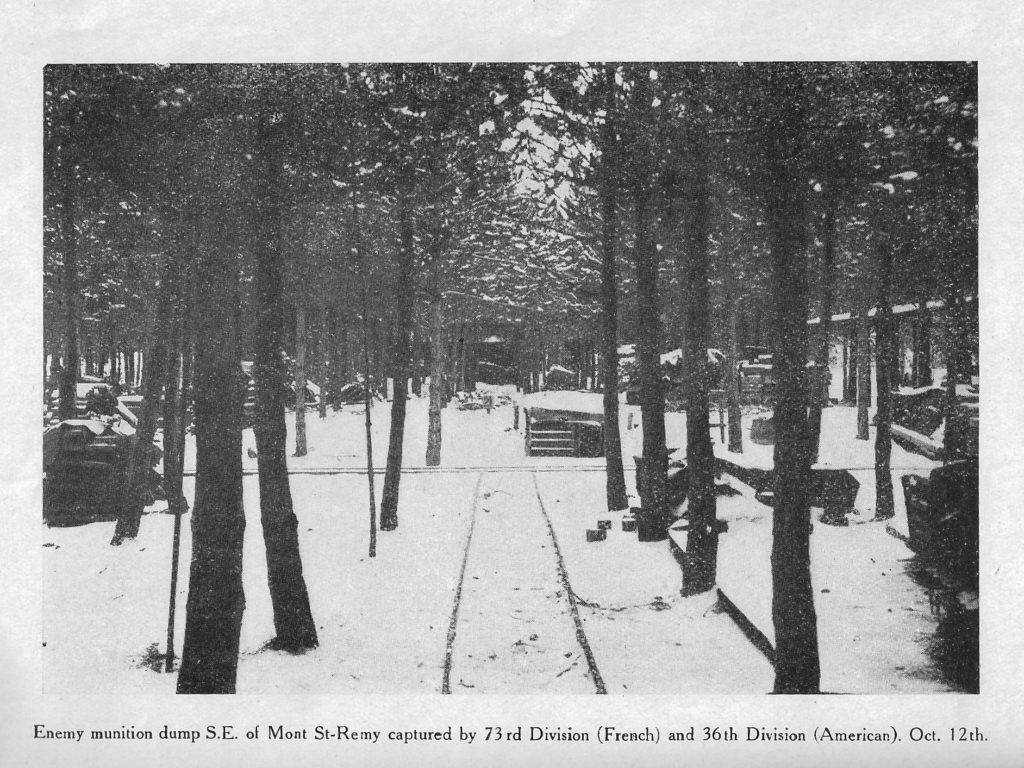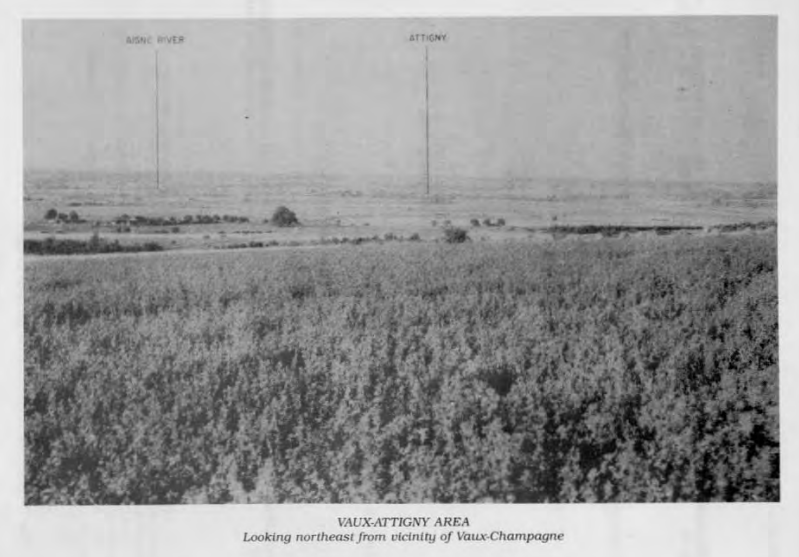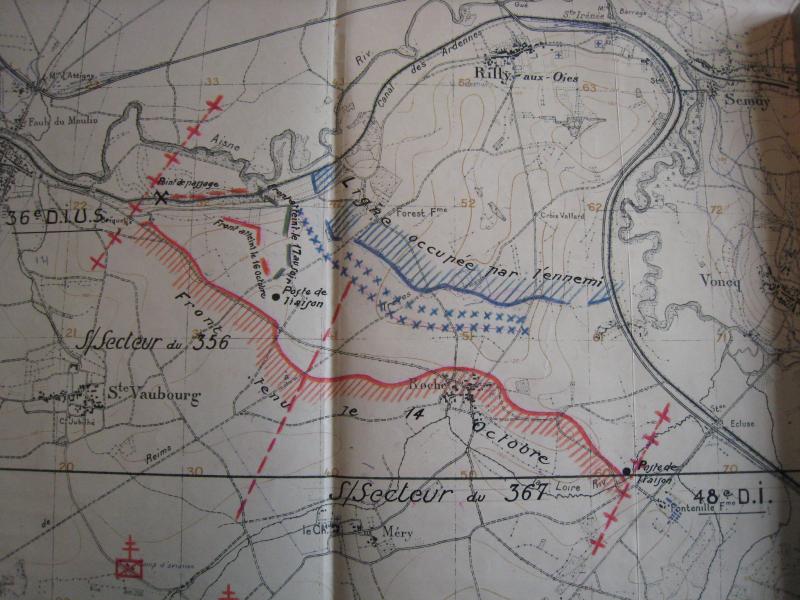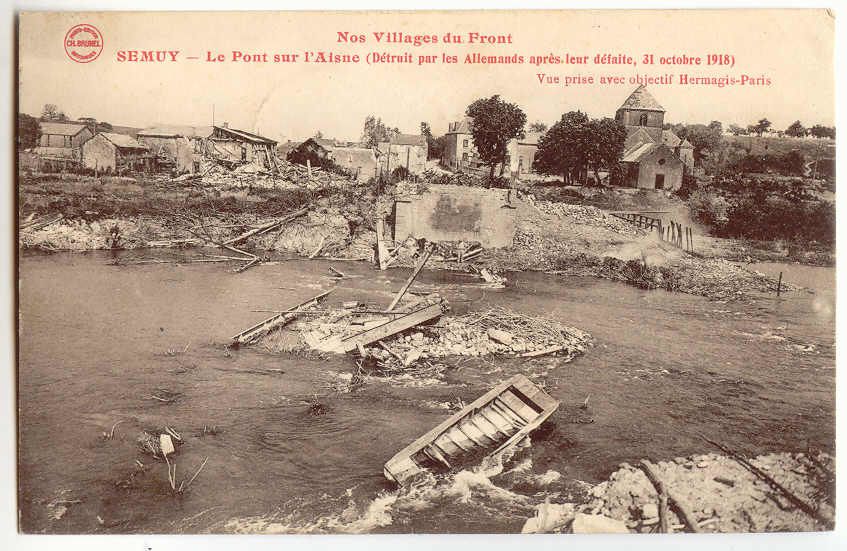
After five days in the combat area, troops of the 71st Brigade made way for the 72nd Brigade. The advance of the 72nd Brigade (143rd and 144th Infantry Regiments, plus the 133rd Machine Gun Battalion) brought the U.S. 36th Division to the edge of the Aisne River in northeast France. Taking the lead on October 11, 1918, the 72nd Brigade advanced from Saint-Étienne unhindered for nearly two kilometers. Halfway between Saint-Étienne and Machault, advance guards of the 144th Infantry received machine gun fire from a small German force. At about the same time, a German spotter plane appeared and artillery began to hit near the troops, causing some casualties in the 144th. German artillery also landed on two abandoned ammunition dumps, causing them to explode.
The advance continues
In the confusion of the explosions, some of the German machine gunners retreated to nearby Machault. On the other hand, the ones who remained were killed in the American advance. As they neared Machault, troops were once again under machine gun fire, this time from the town. Germans had put their guns in the upper floors of some houses there to get the best shot. As the Americans began to work their way around the town, German cannon opened up again. But this time German shells fell on the town as well as outside, and the machine gunners fled.
Machault had been used by the Germans since 1914 to store and move ammunition and supplies to the old front line, about eight miles to the south. Some of the town had been burned by the Germans in an effort to destroy their stores. Just north of the town, in Mont-Saint-Rémy, rows and rows of German artillery shells, lumber and railroad equipment were discovered the next day by the 72nd Brigade and the French 73rd Division. Later, the worth of the German materials left behind at Mont-Saint-Rémy was estimated conservatively at ten million 1918 U. S. Dollars (about $171 million in 2020).

Toward the Aisne
By October 12th, the 2nd U.S. Artillery Brigade had also moved forward. Consequently, American artillerymen began a duel with the Germans, moving their cannon daily to avoid a counter-strike. The same day, American forces reached the crest of the Aisne valley. From here the whole district along the Aisne River and beyond it was clearly visible. However by going down into the valley, the Americans were also seen by the Germans. Leading forces of the 72nd Brigade made their way toward the banks of the Aisne late on the 12th.
Attigny
The largest town in this area is Attigny, on the Aisne River. The Ardennes canal, parallel to the river, made Attigny a center for moving supplies to the old Hindenburg line. A railroad line also passed through Attigny from the northwest. A French cavalry patrol approached the town and found the Germans had set parts of it on fire. They had also done this to Machault and several other towns as they retreated. As they crossed to the north side of the Aisne, the Germans likewise dynamited all the bridges across the river and canal.

But the fires failed to ignite gunpowder and ammunition stores left in Attigny. The next day, October 13th, American patrols entered the town. In addition, they found the Germans had cut down the trees on the south side of the river. This gave them a clear field of fire from the north side. American soldiers approaching the riverbank found the other side protected by German machine guns and their artillery, as usual, accurate. They started taking casualties. In short, the Germans had stopped retreating.
German artillery had a clear view of the American side of the valley, as was seen when American troops moved into the area in force on October 13th. Advancing in the open in daylight, a German barrage hit the 144th Infantry hard; wounding 181 men and killing twenty-eight. As a result, the main American force stayed three or four kilometers away from the river. The zone near the river was guarded by smaller outposts of men spread wide and hidden from sight.

The loop
On the right of the American force and directly in front of the French 73rd Division the Aisne bent northward and, reversing, bent to the southeast. Inside this loop was a town, Rilly-aux-Oies, and a hill covered by farmland. The Germans had retreated to this hill and fortified it, their only outpost on the southern side of the Aisne for miles.
Late on October 13th the rest of the 36th Division arrived at the American front line. Leading forces from the 141st and 142nd Infantry and the 132nd Machine Gun Battalion quietly made their way toward the riverbank. The 141st Infantry was on the extreme right near the French 73rd Division. On October 14th, a patrol from the 141st surprised a German outpost on the river loop and captured six soldiers and four light machine guns.

Stalemate
American and French forces were in a stalemate with the Germans. If the Germans retreated, the Allies must advance. But how to know if the Germans are retreating if one cannot see them? As a result, American and French commanders ordered patrols to observe the German side of the river. Sometimes patrols were ordered into the German line to grab prisoners and gain intelligence. The riverbank was well defended by German machine guns: it was a dangerous game.
Patrols
On the night of October 16, patrols from the 141st and 143rd made their way over the canal and river and snatched two prisoners each. Division headquarters found the German POWs were full of useful information. Likewise the next night a patrol organized by 1st Lieutenant Donald McLennan, scout officer in the 142nd Infantry, made its way toward the canal.
Lt. McLennan had a force of about twenty men, which he felt was too large. After placing most of them on the friendly side of the canal to watch for the enemy, he left to visit the French outpost nearby. He explained his mission to the French soldiers as best he could. In other words, McLennan did not want to be fired upon by an ally on the front line. He returned to his men and picked just three others, Privates Ted Watrous, Lester ‘Red’ Smith and Claude Pierce of C Company.

Enemy territory
McLennan led the patrol across the Ardennes canal into no-man’s land between the canal and the river. Americans had observed sixteen German machine guns in the vicinity. From time to time they would open fire on the small strip of land. Quietly, McLennan found a rickety footbridge across the river and soon enough they were on the German side.
Making their way through dense undergrowth by the river, PFC Ted Watrous motioned to the others that he had found the enemy. Watrous and Smith rushed a foxhole; McClennan came up behind them. McLennan continues:
“I jumped into a small fox hole for a moment and saw two Germans lying off to one side. One of the boys had already shot the smaller one through the arm, I think. The big fellow was no good and showed no nerve and made no resistance. They were too scared to fight I guess, and maybe they thought I had a whole company with me. I didn’t know if we could make it back or not for just a little in front of us they were cracking down pretty lively by that time.”
“Had a notion to cool the big fellow, but I was afraid that with the reckless shooting that was going on they might kill the other and then I would be without a prisoner. So we took a back track and shoved them along in front of us. They let on as though they could not swim but we threw them in and they made it to the planks all right. We got away without any casualty, but how it happened is beyond my understanding. So we returned, the order had been carried out and I delivered two prisoners.”
